
Palaeography (UK) or paleography is the study and academic discipline of the analysis of historical writing systems, the historicity of manuscripts and texts, subsuming deciphering and dating of historical manuscripts, including the analysis of historic penmanship, handwriting script, signification and printed media. It is primarily concerned with the forms, processes and relationships of writing and printing systems as evident in a text, document or manuscript; and analysis of the substantive textual content of documents is a secondary function. Included in the discipline is the practice of deciphering, reading, and dating manuscripts, and the cultural context of writing, including the methods with which writing and printing of texts, manuscripts, books, codices and tomes, tracts and monographs, etcetera, were produced, and the history of scriptoria. This discipline is important for understanding, authenticating, and dating historic texts. However, in the absence of additional evidence, it cannot be used to pinpoint exact dates.

Calligraphy is a visual art related to writing. It is the design and execution of lettering with a pen, ink brush, or other writing instrument. Contemporary calligraphic practice can be defined as "the art of giving form to signs in an expressive, harmonious, and skillful manner".
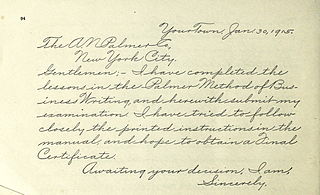
The Palmer Method of penmanship instruction was developed and promoted by Austin Palmer in the late 19th and early 20th centuries. It was intended to simplify the earlier "Spencerian method", which had been the main handwriting learning method since the 1840s. The Palmer Method soon became the most popular handwriting system in the United States.

Cursive is any style of penmanship in which characters are written joined in a flowing manner, generally for the purpose of making writing faster, in contrast to block letters. It varies in functionality and modern-day usage across languages and regions; being used both publicly in artistic and formal documents as well as in private communication. Formal cursive is generally joined, but casual cursive is a combination of joins and pen lifts. The writing style can be further divided as "looped", "italic", or "connected".

Roman cursive is a form of handwriting used in ancient Rome and to some extent into the Middle Ages. It is customarily divided into old cursive and new cursive.

Western calligraphy is the art of writing and penmanship as practiced in the Western world, especially using the Latin alphabet.
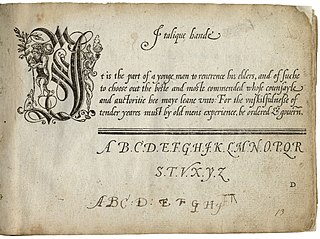
Italic script, also known as chancery cursive and Italic hand, is a semi-cursive, slightly sloped style of handwriting and calligraphy that was developed during the Renaissance in Italy. It is one of the most popular styles used in contemporary Western calligraphy.

The D'Nealian Method is a style of writing and teaching handwriting based on Latin script which was developed between 1965 and 1978 by Donald N. Thurber (1927–2020) in Michigan, United States. Building on his experience as a primary school teacher, Thurber aimed to make the transition from print writing to cursive easier for learners.
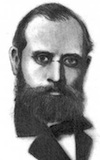
Charles Paxton Zaner was an American calligrapher, pen artist, and teacher of penmanship.
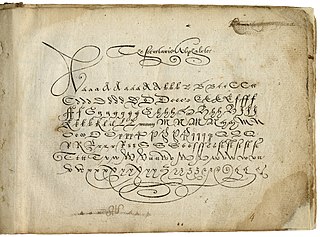
Secretary hand or script is a style of European handwriting developed in the early sixteenth century that remained common in the sixteenth and seventeenth centuries for writing English, German, Welsh and Gaelic.
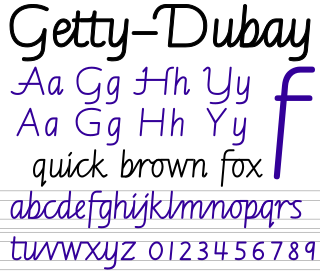
Getty-Dubay Italic is a modern teaching script for handwriting based on Latin script, developed in 1976 in Portland, Oregon, by Barbara Getty and Inga Dubay with the aim of allowing learners to make an easier transition from print writing to cursive.

Spencerian script is a handwriting script style based on Copperplate script that was used in the United States from approximately 1850 to 1925, and was considered the American de facto standard writing style for business correspondence prior to the widespread adoption of the typewriter. Spencerian script, a form of cursive handwriting, was also widely integrated into the school system as an instructional method until the "simpler" Palmer Method replaced it. President James A. Garfield called the Spencerian script, "the pride of our country and the model of our schools."

The Latin script is the most widely used alphabetic writing system in the world. It is the standard script of the English language and is often referred to simply as "the alphabet" in English. It is a true alphabet which originated in the 7th century BC in Italy and has changed continually over the last 2,500 years. It has roots in the Semitic alphabet and its offshoot alphabets, the Phoenician, Greek, and Etruscan. The phonetic values of some letters changed, some letters were lost and gained, and several writing styles ("hands") developed. Two such styles, the minuscule and majuscule hands, were combined into one script with alternate forms for the lower and upper case letters. Modern uppercase letters differ only slightly from their classical counterparts, and there are few regional variants.

The term "chancery hand" can refer to either of two distinct styles of historical handwriting.

Michael Sull is an IAMPETH master penman and author living in Mission, Kansas, United States. An expert on penmanship, he was Ronald Reagan's calligrapher after his presidency and is known worldwide for his skill and teaching ability. He regularly teaches handwriting, calligraphy, and engrossing programs throughout the United States, Europe and Asia.
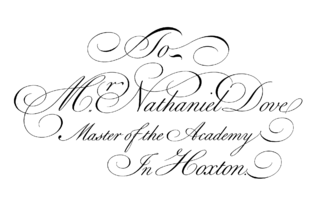
A copperplate script is a style of calligraphic writing most commonly associated with English Roundhand. Although often used as an umbrella term for various forms of pointed pen calligraphy, Copperplate most accurately refers to script styles represented in copybooks created using the intaglio printmaking method.
Zaner-Bloser, Inc., is a company headquartered in Columbus, Ohio, which publishes handwriting, reading, writing, spelling, and vocabulary programs.
Barchowsky Fluent Handwriting (BFH) is a modern teaching script for handwriting based on Latin script, developed in the late 20th century by Nan Jay Barchowsky in Maryland, US, with the aim of allowing learners to make an easier transition from print writing to cursive.

A teaching script is a sample script that serves as a visual orientation for learning to write by hand. In the sense of a guideline or a prototype, it supports the demanding process of developing handwriting skills and abilities in a visual and illustrative way.
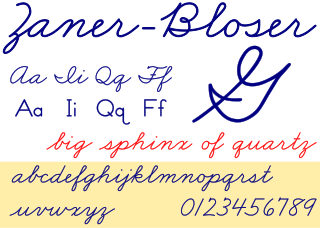
The Zaner-Bloser is a teaching script for handwriting based on Latin script as well as a system of penmanship instruction, which originated around 1904 at the Zanerian College of Penmanship in Columbus, Ohio. Charles P. Zaner (1864–1918) and Elmer W. Bloser (1865–1929), originally a Spencerian Method instructor, developed their teaching script with the aim of allowing learners an easier transition from print writing to cursive. The Zaner-Bloser Method first teaches block letters and then cursive in order to enable written expression as quickly as possible and thus develop the ability to write. Material relating to the method of instruction practiced by Zaner and Bloser is still being published by the Zaner-Bloser Company, a subsidiary of Highlights for Children.




















